“I went looking for the book, but it wasn’t there,” says journalist Flor MacCarthy, explaining how she got the idea for The Presidents’ Letters; an unexpected history of Ireland. The book is a compendium of letters, cards and other paper ephemera both sent and received by all of Ireland’s nine presidents to date.
As to how it found its publisher, New Island Books, MacCarthy was at an event a few years back where Edwin Higel of New Island was also in attendance. As she tells it, their encounter went something like this.
MacCarthy: “Hi Edwin. It must be fierce mad annoying at these things to have people coming up to you all the time and pitching their book ideas at you.”
Higel: “What’s your idea?”
And New Island Books immediately went with her idea.
Like all good ideas that turn into books, it now seems remarkable that nobody else had thought of putting together a collection like this before. MacCarthy pulled out some 315 pieces of correspondence which collectively represent moments in the various presidencies of historical and social significance.
In former years, when much more was communicated solely via paper, there is a correspondingly large physical archive in existence. The presidential archive is sadly not in wooden trunks in some romantic attic in Áras an Uachtaráin.
When an Irish president’s term of office ends, their papers technically belong to the Department of the Office of Taoiseach, as the office of the president comes under that department. Some papers are sent to the National Archives, where the public can access them 30 years later. Others, such as those papers belonging to Éamon de Valera, Cearbhall Ó Dálaigh and Patrick Hillery, are held at designated archives at University College Dublin. There are 660 as-yet uncatalogued boxes of Mary Robinson’s papers in the basement of NUI Galway.
As for the correspondence sent out from the former Viceregal Lodge to citizens public and private, MacCarthy used her long-honed reporting nous to track some of these down.
For example, there is a personal letter of condolence from President Michael D Higgins to singer Shane MacGowan on the death of his mother, Therese, in 2017. It includes the lines: “You have spoken often over the years of the influence your mother has had on your own music and creativity. You have described how, as an award-winning folk singer in her own right, she inspired you to develop your own musical talents.”
How did this personal letter, which is not in any archive, surface?
“I got that letter from Victoria [Mary Clarke] and Shane. I remembered the President attending Shane’s 60th birthday and thought if he was there, he might have given a card. Victoria looked for it and couldn’t find it, but found this one instead,” MacCarthy explains.
It is that kind of resourceful attention to detail, and the willingness to go deeper and try to extend the reach of letters not just from archives, that makes this book so interesting and range so widely. One of MacCarthy’s own favourites is from a number sent between the Áras of de Valera’s presidency and the Grimaldi Palace in Monaco.
In 1962, de Valera sent the gift of an Irish pony called Babbling Brook to the four-year-old Princess Caroline. A groom went with the pony over sea and rail to deliver her safely to the Grimaldis. Princess Grace sent a telegram: “The wonderful pony arrived safely today and we send heartfelt thanks for your kindness and for the joy given to our children.”
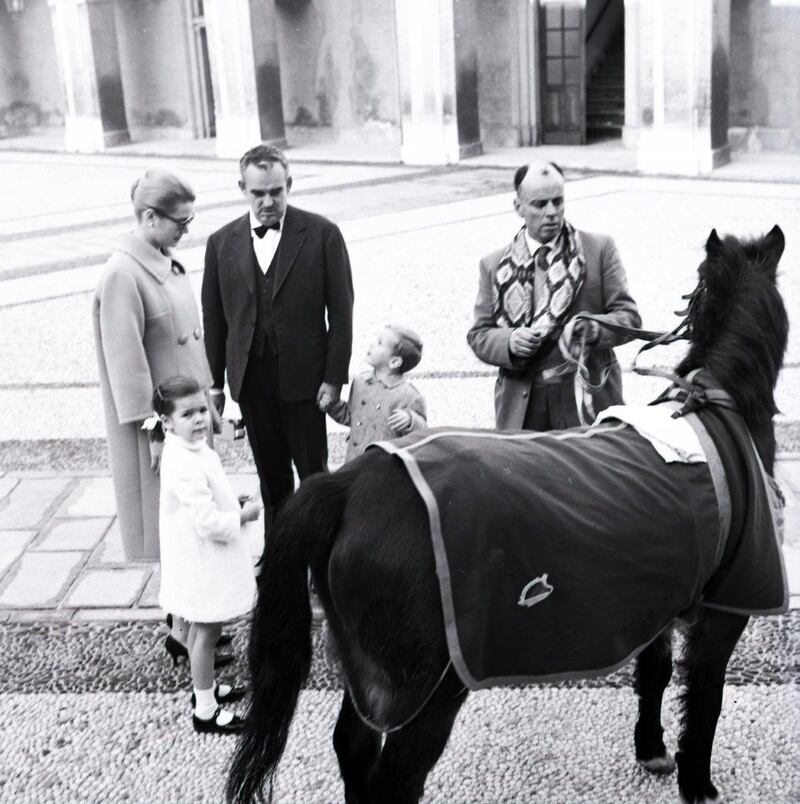
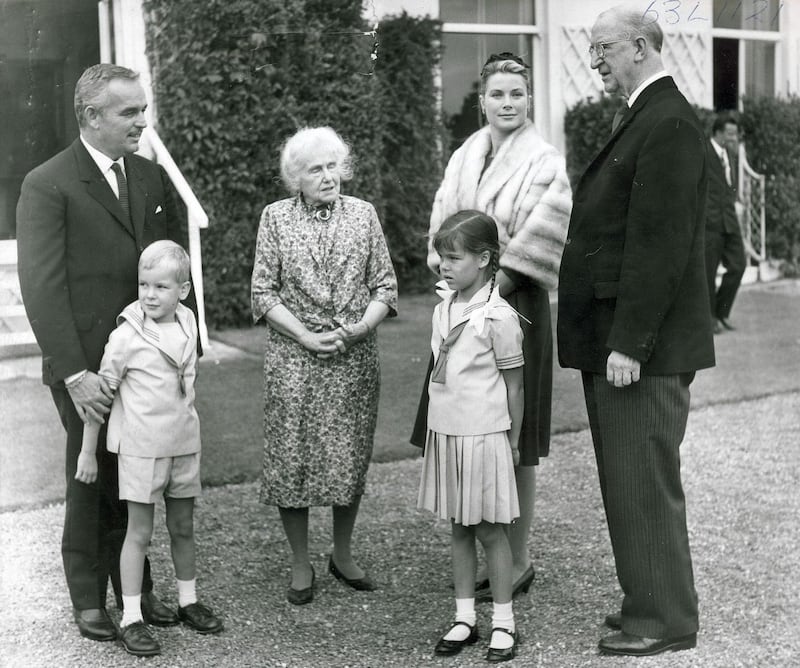
The junior princess later sent a six-word, hand-written card of thanks: “Dear Sir. Thank you. Love Caroline.” To this, de Valera replied: “My dear Princess. Your very nice letter has come to me. I am delighted you like Babbling Brook. As you are fond of her, she will grow very fond of you. When you get more used to her and have some more practice, you can ride her over jumps . . . But it can’t be just yet, I think: your Mammy and Daddy will tell you . . . with love.”
“We all know a certain amount about our presidents and Dev seemed a formidable figure, and yet when you see him signing a letter ‘with love’ to a four-year-old child, it gives you a much more rounded picture of who he was,” MacCarthy says.
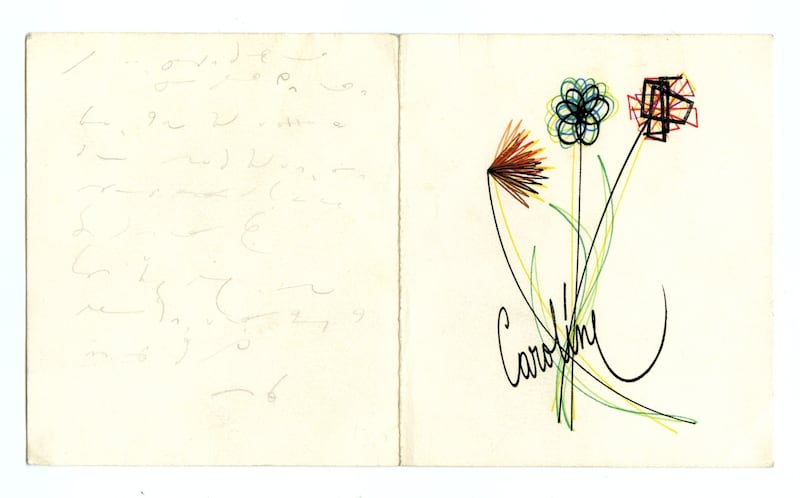


The project took her a year full-time, and then part-time for another year. Interspersed with the letters are contextual essays from several different contributors. They include journalists Harry McGee of this paper, Justine McCarthy, David McCullagh, Martina Devlin, Lise Hand, writer Joseph O’Connor and academic Paul Rouse. Chapter titles include: “Women and the Presidency”, “Politics and the Presidency”, “The Áras and the Arts” and “Church and State”.
“It’s accessible history,” MacCarthy says.
Aside from thank-you cards for ponies from little princesses, there are many landmark letters in the book. One such was written in 1976 by the then minister for defence, Paddy Donegan. He was apologising for infamously calling president O Dalaigh a “thundering disgrace”.
After some back and forth, Donegan writes: “I have expressed my regret and have tendered to you my sincere and humble apology. I feel that I should add that it is now apparent that my words were open to misinterpretation and that they have in fact been subject to interpretation which certainly I did not intend. I would be grateful if you would regard my apology as comprehending my regret for a situation in which such interpretations could arise.”
There is a telegram to Seán T O’Kelly in 1948 from Louis Mountbatten, the then governor general of India, thanking the president for his condolences after the assassination of Mahatma Gandhi. “On behalf of Government and people of India I thank you Mr President most sincerely for your affectionate message of sympathy in the great tragedy that has befallen India . . . Like you I hope that his martyrdom may serve to accelerate the reign over this earth of brotherhood among the peoples.”
There are several other telegrams reproduced in the book. One of them was sent in 1974 to Cearbhall Ó Dálaigh from “the executive council of the Irish Republican Party in Britain.” They urged the president for his “intervention on behalf of Irish political prisoners on hunger strike by virtue of the non-partisan nature of your high office. We trust that the exercise of your influence may avert the tragic deaths of young republicans.”
It is unlikely anyone – although who knows – writes to the Áras these days, hoping that the occupant of the famous white house in Phoenix Park will give them a reference. It used to happen all the time, back in the day, as recorded in the book. There is a “To whom it may concern” letter sent by the secretary to Seán T O’Kelly in May 1952 that any potential employer would hardly have failed to be impressed by.
“The bearer, Christopher O’Flanagan, son of the late Christopher O’Flanagan of 30 Moore Street, Dublin, has asked the President to recommend him for employment. The President has instructed me to say that to his knowledge the O’Flanagan family have over a long period given loyal, devoted and continued service, sometimes entailing very heavy sacrifices to the cause of Irish independence. The President would be happy to see the bearer secure employment suited to his talents and experience.”
A significant piece of our recent history turns up dated March 5th, 2011. The reproduced image in the book doesn’t capture the certain weight of the paper, nor the shine of golden embossed royal emblem stamped at the top, but the words are what count.
“Your Excellency. Thank you for your letter of 4th March [such a swift response!] inviting me to pay a State Visit to Ireland. The Duke of Edinburgh and I are both delighted to accept your invitation. I much appreciate your kind words and I would like to take this opportunity to extend my warmest wishes to you and to the people of Ireland. Your good friend, Elizabeth R.”
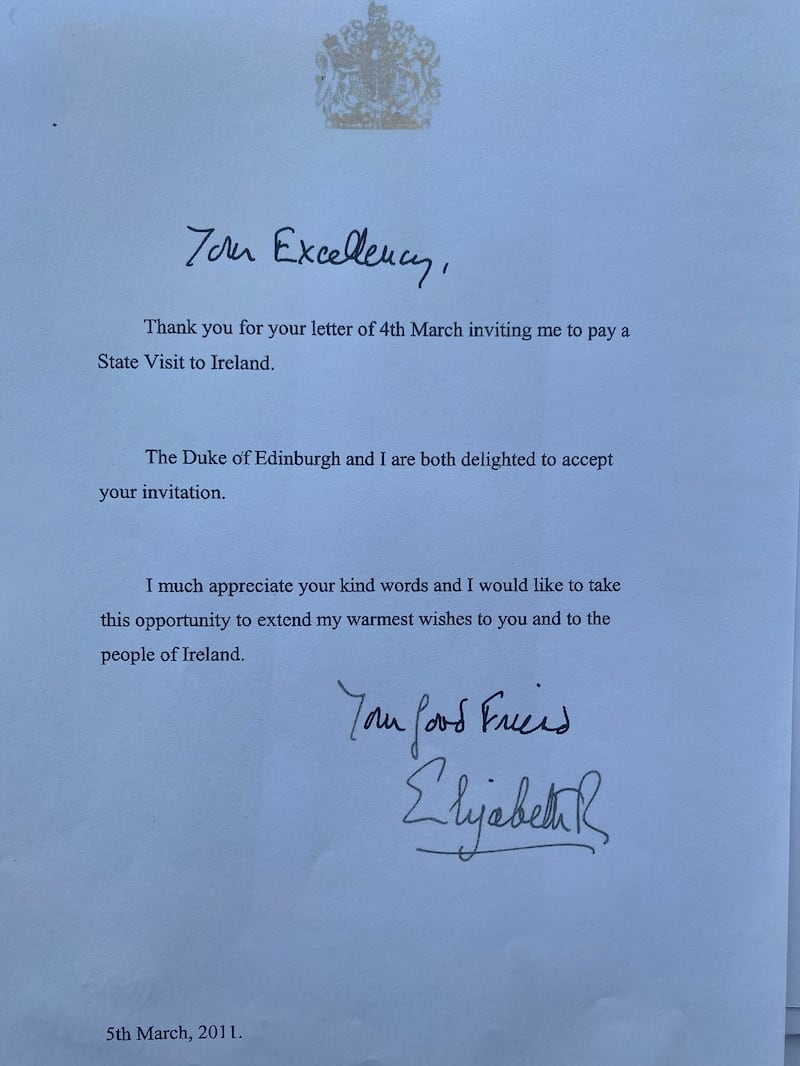
It wasn’t just heads of state who have been writing to our presidents over the decades. Children have been writing letters too. Nine-year-old Elaine Buckley wrote to Mary Robinson in 1991. “Dear Mrs President. Congratulations on your first anniversary of being President. Also for being our first Lady President. I am a great fan of yours.”
There are many hand-written letters among the archives, and the individual handwriting styles all add character and personality to the words. On the death of her husband, John F Kennedy, Jacqueline Kennedy wrote a heartfelt four-page letter to Éamon de Valera on January 22nd, 1964 , thanking him for attending the funeral and emphasising the family’s connection to Ireland.
“Dear Mr President. I do wish to thank you with all my heart for coming to my husband’s funeral – and for bringing with you the Irish cadets – who had moved him so a few months before in Ireland – and who then moved the world at his grave.
“I am only grateful for one thing in these sad days – that he did have the chance to return to Ireland as President of the United States last summer. That trip meant more to him than any other in his life. He called me every night of it and would tell me all that had passed that day.
“He would never have been President had he not been Irish. All the history of your people is a long one overcoming obstacles. He felt that burden on him as a young Irishman in Boston – and he had so many obstacles in his path – his religion, his health, his youth. He fought against each from the time he was a boy and by always striving, he ended as President . . .
“I know your country mourned him as much as his own country did – and through you I thank them for that. I will bring up my children to be as proud of being Irish as he was. Already our horse is named “Wexford” . . . Whenever they see anything beautiful or good they say, ‘That must be Irish.’ And when they are old enough I will bring them there.”
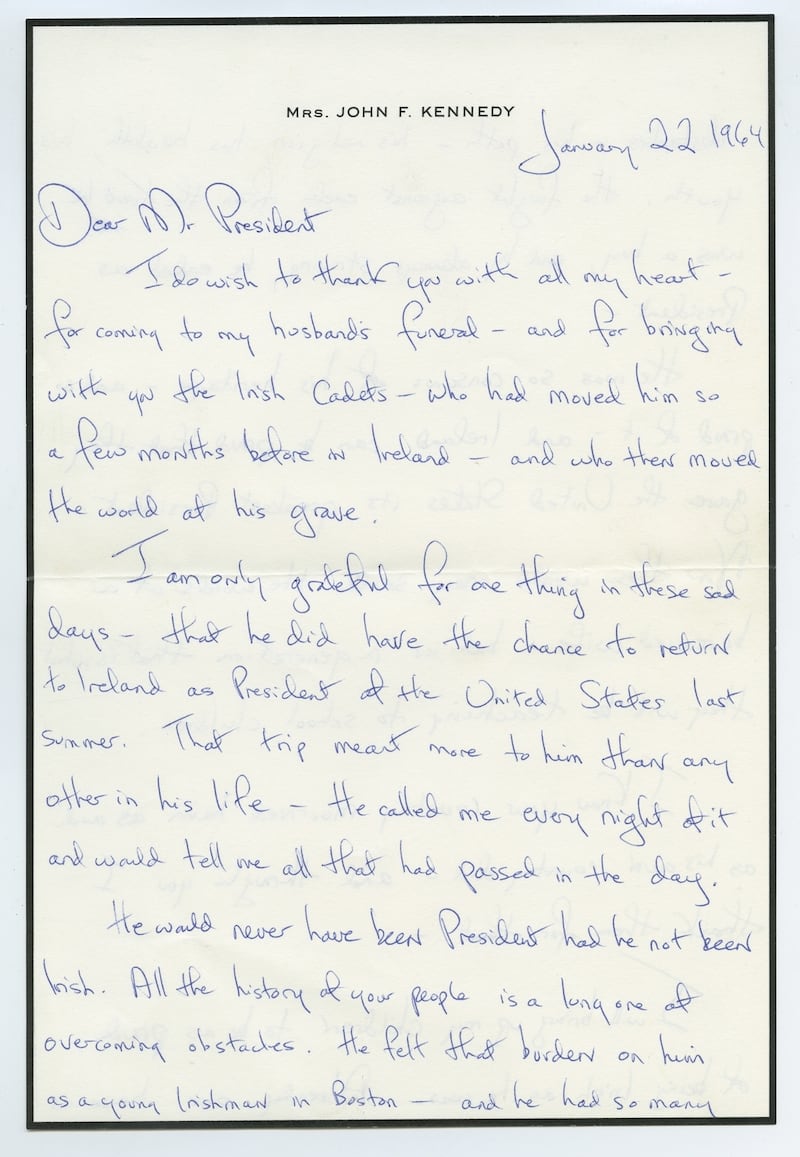
In 2021, more than half the correspondence that now passes through the Áras is via email. Some of them are reproduced here, and while the intention behind them is clear, it’s fair to say the email is a very unlovely visual piece of correspondence. The grammar and syntax too seem to be far less accurate than those of earlier years – which is probably why the name of the author of this email below, sent to Mr Higgins after his state visit to Britain in 2014, is not given: the sender’s ears might blush, seeing it in print.
“Thx a mil Prez. U did us all so v v proud. Im proud to call myself Irish on account of the really powerful job u did for us all in the UK this last week. Maith thu.”
“Personally, I think it’s a shame that the era of letters is probably gone.” MacCarthy says. “Electronic communication is where we are at.”
It’s not just Irish presidents who have a correspondence output. The canine residents of the Áras, Bród and Misneach, have their own Twitter account, with a much larger following than many humans. Misneach arrived to the Áras last year as a puppy after the death of Síoda, also a Bernese Mountain Dog.
There is a reproduction of a very sweet letter and drawing from eight-year-old Donnchadh Guilfoyle, which arrived after Síoda’s death. Along with a drawing of something that looks a little like a dog (it definitely has a tail), with a broken heart over it’s head, is this letter in very wobbly handwriting: “To President Michael D Higgins. I am sorry to hear about Síoda. She was a good girl. I hope you and Bród are okay. I was sad when my cat died. So I know that you are too. Donnchadh”

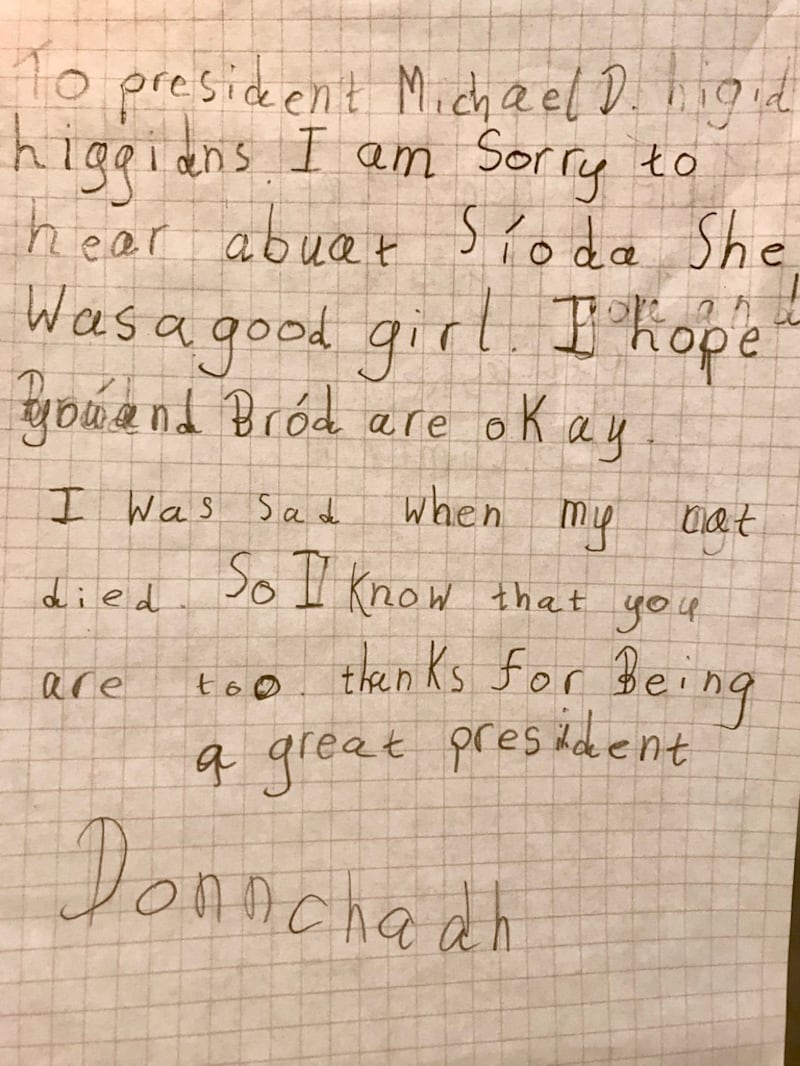
So does MacCarthy have a new project in mind? “Volume two!” she replies. “There is so much material out there.” She is hoping that once members of the public see the book, they may go searching for letters or cards that were sent to them or to other family members by one or more of our nine presidents. “Maybe those letters could be part of volume two.”
The Presidents' Letters: An Unexpected History of Ireland by Flor MacCarthy is published by New Island Books











